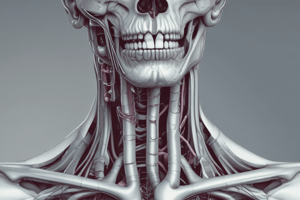Podcast
Questions and Answers
Which of the following is the largest laryngeal cartilage?
Which of the following is the largest laryngeal cartilage?
- Thyroid cartilage (correct)
- Arytenoid cartilage
- Epiglottis
- Cricoid cartilage
Which of the following forms a lid over the glottis?
Which of the following forms a lid over the glottis?
- Thyroid cartilage
- Arytenoid cartilage
- Cricoid cartilage
- Epiglottis (correct)
Which of the following structures is commonly referred to as the Adam's apple?
Which of the following structures is commonly referred to as the Adam's apple?
- Thyrohyoid ligament
- Corniculate cartilage
- Laryngeal prominence (correct)
- Cricothyroid ligament
During inhalation, what happens to the diaphragm and rib muscles?
During inhalation, what happens to the diaphragm and rib muscles?
From which structures do oxygen molecules move from the lungs to the blood?
From which structures do oxygen molecules move from the lungs to the blood?
Which statement is correct about oxygen in the blood?
Which statement is correct about oxygen in the blood?
After blood becomes oxygenated, what happens?
After blood becomes oxygenated, what happens?
What is hemoglobin?
What is hemoglobin?
As air moves from the nasal cavity to the glottis it passes through the pharynx in this order, __________.
As air moves from the nasal cavity to the glottis it passes through the pharynx in this order, __________.
If the production of surfactant by type II alveolar cells (septal cells) is inadequate, which of these changes is expected?
If the production of surfactant by type II alveolar cells (septal cells) is inadequate, which of these changes is expected?
Boyle's law states gas pressure is __________.
Boyle's law states gas pressure is __________.
The respiratory centers are located in __________.
The respiratory centers are located in __________.
Which of the following structures or organs is NOT part of the upper respiratory system?
Which of the following structures or organs is NOT part of the upper respiratory system?
What is the name of the respiratory tract passageway that leads directly into each lung?
What is the name of the respiratory tract passageway that leads directly into each lung?
Which of the following serves as a passageway for BOTH food or liquids and air?
Which of the following serves as a passageway for BOTH food or liquids and air?
Which of these changes will decrease the effectiveness of gas exchange across the respiratory membrane?
Which of these changes will decrease the effectiveness of gas exchange across the respiratory membrane?
The respiratory epithelium of the conducting airways consists of __________.
The respiratory epithelium of the conducting airways consists of __________.
Flashcards are hidden until you start studying
Study Notes
Laryngeal Cartilage
- Thyroid cartilage is the largest laryngeal cartilage.
- Epiglottis acts as a lid over the glottis.
- Laryngeal prominence, commonly known as Adam's apple, is a prominent feature formed by thyroid cartilage.
Respiratory Mechanics
- During inhalation, both the diaphragm and rib muscles contract to increase thoracic cavity volume.
- Oxygen diffuses from alveoli into blood vessels, specifically from the lungs to the blood.
- Hemoglobin in red blood cells binds up to four molecules of oxygen.
Blood Oxygenation and Transport
- Oxygenated blood returns to the heart before being pumped to body cells.
- In the blood, oxygen is bound to hemoglobin, facilitating transport to tissues.
Respiratory Pathways
- Air passes through the nasal cavity, then the nasopharynx, oropharynx, and laryngopharynx before reaching the glottis.
- The bronchus serves as the passageway that leads directly into each lung.
- Pharynx is the structure that facilitates the passage of both food and air.
Gas Exchange
- Changes such as increased thickness of the respiratory membrane decrease the effectiveness of gas exchange.
- Surfactant production by type II alveolar cells is critical; inadequate production can cause respiratory distress syndrome and alveolar collapse.
Laws of Gas Behavior
- Boyle's Law asserts that gas pressure is inversely proportional to the volume.
Respiratory Control Centers
- Respiratory centers are located in both the medulla oblongata and the pons.
Upper Respiratory System
- Larynx is not part of the upper respiratory system, which includes internal nares, pharynx, and nasal conchae.
Histology of Airway Epithelium
- Conducting airways are lined with pseudostratified ciliated columnar epithelium, aiding in mucous clearance and protection.
Studying That Suits You
Use AI to generate personalized quizzes and flashcards to suit your learning preferences.




